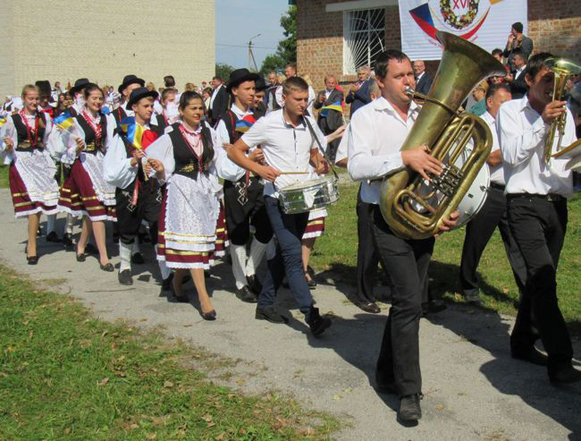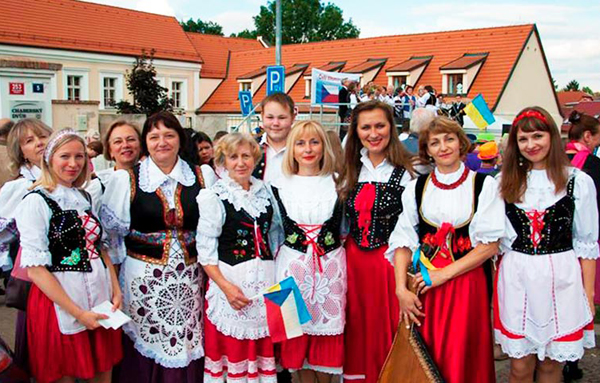Czechs
Czechs [чехи; chekhy]. A West Slavic people related closely to the Lusatian Sorbs and Slovaks. The Czechs are now settled mostly in the Czech Republic, which was established at the start of 1993 following the dissolution of Czechoslovakia. In 2019 there were 7,266,809 Czechs (including Moravians and Czech Silesians) in the Czech Republic, constituting 68.8 percent of its population. Czechs can also be found in the United States (1,462,000), Canada (294,800), the United Kingdom (145,000), Austria (136,000), Slovakia (104,400), and in smaller concentrations in Australia, France, Ireland, Norway, and other countries. In 1959 there were 14,500 Czechs in the Ukrainian SSR; about 70 percent of them gave Czech as their mother language, while 23 percent gave Ukrainian. According to the 2001 census, there were 5,917 Czechs living in Ukraine. These are the remnants of a larger Czech minority on Ukrainian territory in the past. Altogether there are over 11 million Czechs around the world today.
Czechs in Ukraine. Economic, military, and cultural ties between Bohemia and Ukraine account for small Czech settlements in Kyivan Rus’ as early as the 13th century. The Polish chronicler Jan Długosz (1415–80) noted that, during a famine in Bohemia in 1281–2, some Czech families moved to the Halych principality. During the reign of Yurii II Boleslav, Czech immigrants were members of his retinue and of the local nobility. G. Chodko, the son of Jeromiř, was an adviser to the prince, while Chodko Otek was the palatine of Lutsk.
Under Władysław Opolczyk traders, craftsmen, and some nobles emigrated to Ukraine. Some of the Roman Catholic clergy and even bishops on Rus’ territories were Czechs. Later, Czech mercenaries served in the Polish army, mostly as guards on the Polish-Moldavian border along the Dnister River. J. Černin commanded an expedition to Moldavia in 1509. In Ukraine and Lithuania the Czechs were known as artillerymen in Polish companies and castles.
Individual Czechs settled in Peremyshl, Kolomyia, and Kholm, but mostly in Lviv, which in the 15th century attracted colonists from Czech and German lands because of its economic importance. In this period there were several surnames among the burghers of Lviv that indicated their place of origin (eg, those having the names Chekh, Chesky, and others). One of these burghers, N. Bohemus, built a chapel in honor of Saints Vitus, Václav, and Procopius. In the 15th century Albert Czech Tuchampsky (Albertus dictus Czech de Tuczamp) was mayor of Lviv. During the religious wars in Bohemia and particularly after the Battle of Bilá Hora (1620) some members of the Unity of Brethren sought refuge in Western Ukraine. One of the leading Brethren, J. Brosius, settled with his followers in Volodava, Podlachia, in the 1630s. In 1634 a conference of the Unity of Brethren communities in Poland and Lithuania took place there with the participation of Jan Amos Comenius.
Czechs played a role in the history of the Ukrainian Cossacks. According to one hypothesis proposed by F. Palacký and Volodymyr Antonovych, the Czech prince Frederick (Bedřich) of Ostroh was one of the organizers of the movement. This hypothesis was rejected by Mykola Kostomarov. Czech influences are evident in the terminology used by the Cossacks, the organization of Cossack encampments, and their military tactics. Among Cossack officers, the Orlyk family, of which Hetman Pylyp Orlyk was a member, was of Czech origin. General J.B. Weisbach served under Peter I and took part in the Battle of Poltava. In 1735 he was appointed governor of Kyiv. The tsar endowed him with large estates, which had belonged formerly to Ivan Mazepa and his Cossack starshyna officers. Weisbach set up various enterprises, particularly a textile industry.
In the 18th–19th century Czech musicians with their kapellen (hudby) toured the towns of Ukraine and were widely known. Ivan Prach, Aloiz Jedlička, and J. Landver were best known among them. Czech merchants and craftsmen visited Ukraine, and Czechs served as Austrian civil servants in Galicia and Bukovyna. Czech brewers were widely reputed.
In the 1860s whole colonies of Czech farmers began to settle in Ukraine, mostly in Volhynia. In Rivne a special commission for Czech resettlement was set up. After the abolition of serfdom the Czechs could purchase landowners’ estates on favorable terms, particularly in the counties of Dubno, Lutsk, Ostroh, Zhytomyr, and Volodymyr-Volynskyi in Volhynia gubernia, but also in Kherson gubernia, Tavriia gubernia, and the Kuban. The following villages were the principal settlements of the Czechs: Liudhardivka (1863) in Volhynia, Chekhivka in Podilia, Tabir, Bohemka, Parevych in the Crimea, and Chekhohrad near Melitopol. In 1870 the Russian government permitted the Czechs to become Russian subjects. They were registered as peasants, came under the local administration, and could set up their own rural districts (see volost) or join existing ones. Four Czech districts were formed: Rivne, Dubno, Lutsk, and Kupychiv. The other Czech settlements belonged to Ukrainian districts. Altogether there were about 130 Czech settlements, and by the beginning of the 20th century the Czech population in Ukraine reached 65,000. Almost all of the Volhynian Czechs converted to the Orthodox faith. The first Czech publications were religious and included Český pravoslavný kalendář of 1888, published first in Kyiv by F. Jareš, a teacher at Galagan College, and then in Zhytomyr. Some of the Czechs retained their Protestant faith (eg, the Czech Brethren).
For a long time the Czech settlements retained their distinctive character while adopting some of the forms of the Ukrainian milieu. In the towns the immigrants became assimilated more rapidly. Because of their progressive farming methods and skills, the Czechs prospered. They had their own schools, press, associations, and co-operatives. They imported farm machinery from Bohemia, and their farming methods and technology were imitated by their Ukrainian neighbors.
In Kyiv the newspaper Ruský čech was edited by V. Vondrák in 1906–8, followed by Čechoslovan, edited by V. Švihovský and V. Charvát in 1911–14 and 1916–18, which advocated the liberation of Bohemia and Slovakia from Austria-Hungary. In August 1914 the local Czechs in Kyiv set up the military organization Česká Družina, which became the base for the later Czechoslovak Legion in Ukraine and Russia. These military organizations were joined by Czech and Slovak prisoners of war who had served in the Austro-Hungarian army and who by the end of 1917 numbered over 200,000. Československý dennik and Československý vojak appeared briefly in Kyiv. The Czechoslovak National Council, headed by B. Čermák, had its seat there and maintained friendly relations with the Ukrainian Central Rada. (For Czech-Ukrainian political ties, see Czechoslovakia.)
In the Ukrainian National Republic the rights of the Czech minority were guaranteed by a law on national and personal autonomy. In February–March 1918 only a small number of Ukrainian Czechs retreated eastward with the Czechoslovak Legion. At the conclusion of the Peace Treaty of Riga about 20,000 Czechs found themselves in Poland. In the 1920s there were 12 Czech rural soviets in the Ukrainian SSR. In 1926 there were 17,500 Czechs in the Ukrainian SSR and the Crimean ASSR. They had their own elementary schools.
During the Second World War the so-called Volhynian Czechs supported the effort to form Czechoslovak military units and in 1944 volunteered for the Czechoslovak Brigade. In accordance with the Czechoslovak-Soviet treaty of 1945, many Czechs returned to their ancestral homeland. Only slightly over 10,000 Czechs stayed behind, mostly in Zhytomyr oblast.
Another Czech group that lived among Ukrainians was the community in Transcarpathia in 1919–39. Its members were civil servants who were assigned to serve there in the administrative agencies, schools, transport system, and military. Some merchants and industrialists settled there also. A few hundred farmers moved to southern Transcarpathia in connection with the agrarian reforms in some of the villages there. The number of Czechs in Transcarpathia increased to 30,000. Their above-average education, professional training, and status as representatives of the ‘governing nation’ assured them of a privileged position. There were special blocks (called colonies) inhabited mostly by Czechs in the towns. A Czech educational system was set up. In 1935 there were 3 Czech gymnasiums, 1 teachers' college, 23 junior high schools, and 182 elementary schools. As a rule, the Czechs did not learn Ukrainian and did not assimilate. On the contrary, they promoted the Czechoslovakization of the region. The Czech press flourished with such newspapers as Podkarpatské hlasy (an independent semiweekly, 1925–38), Hlas východu (Social-Democrat weekly, 1928–33), and Karpato-ukrajinská svoboda and Přehled z Karpatské Ukrajiny (both weeklies, 1939). Under the autonomous state of Carpatho-Ukraine the number of Czechs living in the region diminished somewhat. They were represented in the diet by M. Drbal. During the Hungarian occupation all Czechs left Transcarpathia.
BIBLIOGRAPHY
Auerhan, J. České osady na Volyni, na Krymu a na Kavkaze (Prague 1920)
———. Osady českých emigrantů v Prusku, Polsku a Rusku (Prague 1920)
Rykhlik, Ie. ‘Doslidy nad ches'kymy koloniiamy na Ukraïni,’ in Zapysky Etnohrafichnoho tovarystva, 1 (Kyiv 1925)
Karas, F. Obrazy z českých osad v Polsku (Prague 1935)
Florovskii, A. Chekhi i vostochnye slaviane, 2 vols (Prague 1935–47)
Veselý, J. Chekhi i slovaki v revoliutsionnoi Rossii, 1917–1920 gg., trans F. Chumalo (Moscow 1965)
Palicka, V. Nezaváté casem: Volyntsí Česi v tankových bojích (Prague 1995)
Drbal, O. et al (eds). Chekhy v Halychynia: Biohrafichnyi dovidnyk (Lviv 1998)
Vasyl Markus
[This article was updated in 2020.]

